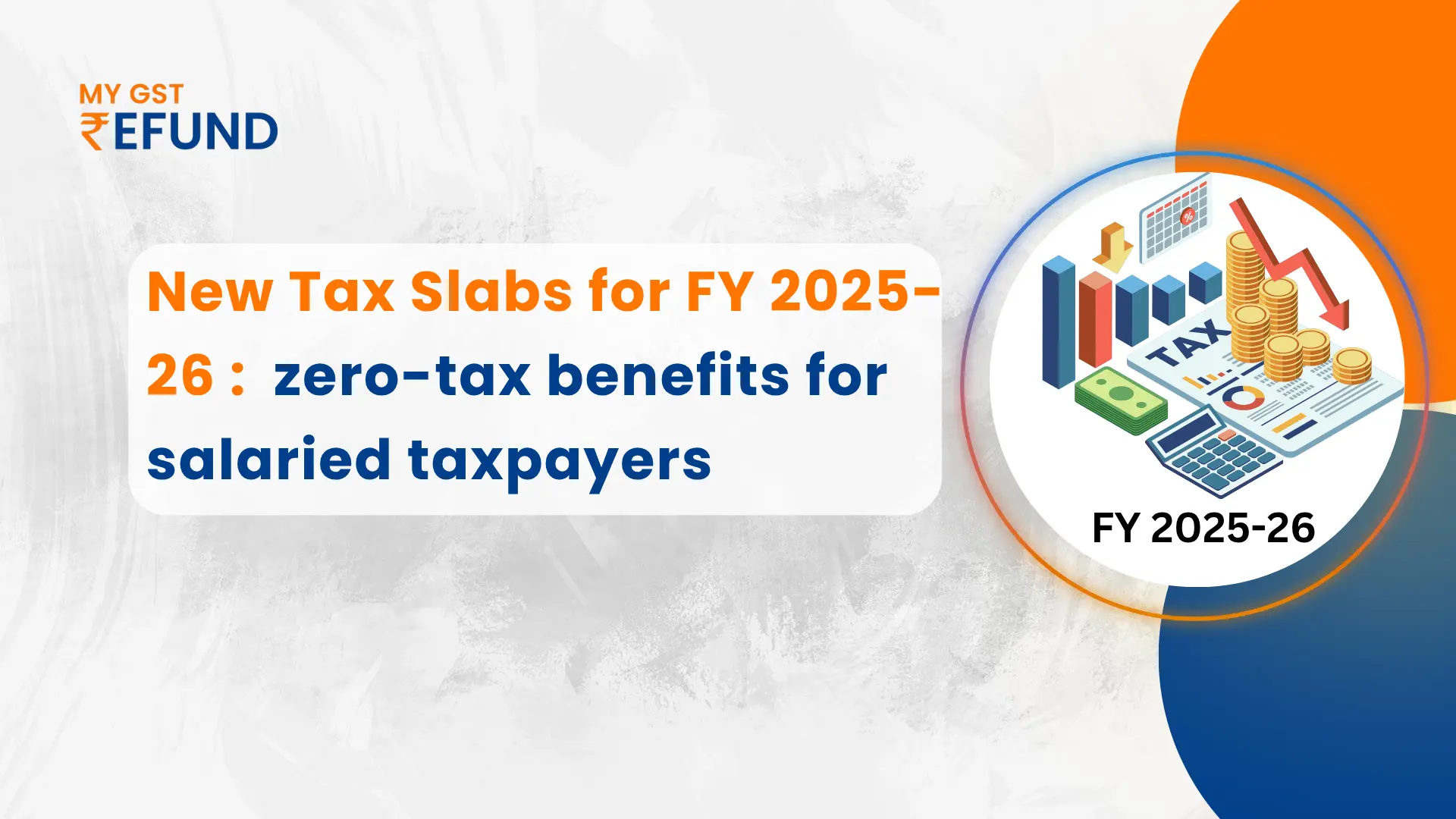New Tax Slabs for FY 2025-26 | Old vs New Regime
Published on: Wed Oct 08 2025
Bio (Reveal/Hide)

New Tax Slabs for FY 2025-26: Old vs New Regime Compared (Zero Tax up to ₹7 Lakh)
Indian citizens are given the option to select either the Old Tax Regime or the New Tax Regime by default for the fiscal year 2026–2027. The choice is retained purely based on the expenditure and investment, and income pattern of the individual.
The New Tax Regime (Default Option)
The choice is to offer reduced rates of taxation by eliminating all such normal allowances and deductions.
Key Point: Zero Tax till ₹7 Lakh! The most coveted benefit of the new scheme is the Section 87A rebate. If your net tax payable income is only up to ₹7 lakh, your tax liability comes down to zero.
Under the ₹50,000 benchmark exemption, this benefit is provided to salaried classes with an income of ₹7.5 lakh.
Fiscal Year 2025–2026 Tax Slabs: No taxes up to ₹3,00,000
- Between ₹3,00,001 and ₹6,00,000, five percent
- Ten percent of 6,00,001 to 9,00,000
- 15% between 9,00,001 and 12,00,000 Between ₹12,000,000 and ₹15,000,000, 20%
A Brief Comparison of the New and the Old
| Feature | New Tax Regime | Old Tax Regime |
|---|---|---|
| Basic Exemption | ₹3 Lakh | ₹2.5 Lakh |
| Zero Tax Income | Up to ₹7 Lakh (owing to rebate) | Up to ₹5 Lakh (owing to rebate) |
| Key Benefit | Low rates of tax, ease | Freedom to claim deductions |
| Deductions (80C, etc.) | Not permitted | Permitted |
| Default Option | Yes | No (Must opt-in) |
An increased rebate in tax amounts to NO tax on income up to ₹7 lakh under the new plan.
Same Fixed Deduction of ₹50,000 under the new plan as well.
The New Tax Regime: A Breakup of the Slabs for FY 2025-26
For FY 2025-26 (A.Y. 2026-27), the new plan will be the default choice of the taxpayers. Unless all of them do not desire to be taxed under the new plan, he or she shall have to opt positively for the old plan while submitting returns. Tax slabs in your query are erroneous.
Official slabs under the new plan have a different rate structure
- Individual filers under the new tax regime are eligible for a general deduction of ₹50,000 on salary income.
- Section 87A rebate is one of the new items of this new scheme. Taxpayers with an income of ₹7 lakh or less would not have to shell out anything from their income due to this rebate.
Statutory slabs and tax rates on income in the new slab of FY 2025-26 are as under:
| Income Slab (₹) | Tax Rate |
|---|---|
| Up to ₹3,00,000 | 0% (Nil) |
| ₹3,00,001 to ₹6,00,000 | 5% |
| ₹6,00,001 to ₹9,00,000 | 10% |
| ₹9,00,001 to ₹12,00,000 | 15% |
| ₹12,00,001 to ₹15,00,000 | 20% |
| Above ₹15,00,000 | 30% |
What is a Tax Rebate?
A tax rebate is a relief of tax given by the state to the taxpayers. It is actually just a rebate or taxation to be reimbursed by taxpayers whose incomes are not more than a certain level. The most basic function of a rebate of taxation is to relieve the taxation burden for people earning low incomes so that they would be contributing less towards taxation, thereby promoting conformity with taxation. It is not a deduction of the overall gross income; the rebate is cut directly from the tax amount payable.
New Rebate Limit for FY 2025-26
Section 87A of the Income Tax Act provides for a fair tax refund for the assessee who chooses to use the new taxation regime for the Financial Year 2025–26 (Assessment Year 2026-27). By doing so, if the net taxable income is ₹7,00,000 or below, then he would be getting a refund on the taxes and his tax payable shall be nil. For example, For instance, if they decide to take part in the new program, people who make ₹7,00,000 or less a year are excused from paying any income tax.
It's also important to remember that under the proposed plan, even pensioners and salaried individuals would qualify for a baseline deduction of ₹50,000. It suggests that a salaried individual with a maximum income of ₹7,50,000 would have a taxable income of ₹7,00,000 (after basic deduction) and would not be subject to taxes.
How the Rebate Works: An Illustrative Example
To know that an individual with ₹7,00,000 income will not have to give anything as tax under the new scheme for FY 2025-26, let's do it step by step:
Assumptions:
Gross Taxable Income: ₹7,00,000
Tax Regime: New Tax Regime
Step 1: Taxable Income. Since there are no deductions (such as Section 80C, 80D, etc.) under the new tax regime, taxable income will be equal to the gross income.
Taxable Income = ₹7,00,000
Step 2: Slab Rate of Income Tax for FY 2025-26 (New Regime)
Slab to be used is as given below:
Up to ₹3,00,000: Nil
₹3,00,001 to ₹6,00,000: 5%
₹6,00,001 to ₹9,00,000: 10%
Tax paid is as given below:
On first ₹3,00,000: ₹0
On next ₹3,00,000 (₹3,00,001 to ₹6,00,000) @ 5%: ₹15,000
On last ₹1,00,000 (₹6,00,001 to ₹7,00,000) @ 10%: ₹10,000
Total Tax before Rebate = ₹15,000 + ₹10,000 = ₹25,000
Step 3: Rebatement under Section 87A Being in the slab of ₹7,00,000, taxable income (₹7,00,000) gets a rebate to the taxpayer. Rebate is either the lower of tax payable or a fixed amount. In this case, a higher limit rebate of ₹25,000 is exempted.
Tax Payable before Rebatement: ₹25,000
Against Rebatement under Section 87A: ₹25,000
Step 4: Final Tax Liability
Net Tax Payable = ₹25,000 - ₹25,000 = ₹0
Therefore, Section 87A tax rebate takes an individual with the tax incidence of up to ₹7,00,000 to zero under the new scheme of AY 2025-26.
The Old vs. New Tax Regime: A Comparative Analysis
It is a big money decision for every taxpayer, which new or old tax regime to opt for to earn income. Even if the tax slabs have come down in the new regime, in the old regime, you received exemptions and deductions on some things. Comparing this way, you will be able to choose according to your purse.
Comparison of Tax Slabs
The following are comparative slabs of income tax under both regimes for FY 2025-26.
| Income Slab (₹) | Old Tax Regime Rates | New Tax Regime Rates (Uniform for all) |
|---|---|---|
| Individuals below 60 years | ||
| Up to 2,50,000 | No Tax | No Tax (up to ₹3,00,000) |
| 2,50,001 to 5,00,000 | 5% | 5% (on ₹3,00,001 to ₹6,00,000) |
| 5,00,001 to 10,00,000 | 20% | 10% (on ₹6,00,001 to ₹9,00,000) & 15% (on ₹9,00,001 to ₹12,00,000) |
| Above 10,00,000 | 30% | 20% (on ₹12,00,001 to ₹15,00,000) & 30% (above ₹15,00,000) |
| Senior Citizens (60 to 80 Years) | ||
| Up to 3,00,000 | No Tax | – |
| 3,00,001 to 5,00,000 | 5% | – |
| 5,00,001 to 10,00,000 | 20% | – |
| Above 10,00,000 | 30% | – |
| Super Senior Citizens (Above 80 Years) | ||
| Up to 5,00,000 | No Tax | – |
| 5,00,001 to 10,00,000 | 20% | – |
| Above 10,00,000 | 30% | – |
Key Takeaway: Lower slabs and lower rates with the minimum exemption limit of ₹3,00,000 to all under the new regime, as opposed to the previous regime of differently sloping slabs based on age.
Who Chooses Which Regime to Avail?
The new regime or the old regime largely hinges upon your income and eligible deductions.
Sample Calculation
Assuming that under the previous tax system, a salaried taxpayer's gross income was ₹12,000,000 and that their deductible allowance was ₹2,50,000 (₹150,000 under section 80C, ₹50,000 HRA, and ₹50,000 standard deduction).
| Particulars | Old Tax Regime (₹) | New Tax Regime (₹) |
|---|---|---|
| Gross Income | 12,00,000 | 12,00,000 |
| Less: Deductions | 2,50,000 | 50,000 (Standard Deduction only) |
| Taxable Income | 9,50,000 | 11,50,000 |
| Tax Calculation | ||
| Up to 2,50,000 | 0 | – |
| 2,50,001 to 5,00,000 | 12,500 | – |
| 5,00,001 to 9,50,000 | 90,000 | – |
| Up to 3,00,000 | – | 0 |
| 3,00,001 to 6,00,000 | – | 15,000 |
| 6,00,001 to 9,00,000 | – | 30,000 |
| 9,00,001 to 11,50,000 | – | 37,500 |
| Total Tax | 1,02,500 | 82,500 |
| Add: 4% Cess | 4,100 | 3,300 |
| Total Tax Liability | 1,06,600 | 85,800 |
Here, the new regime is better because the aggregate tax expenditure is less. However, if the aggregate deductions under the old regime for a particular taxpayer were greater, then maybe the old regime could have been better.
Why the Maximum Income of ₹7 Lakh is Tax-Free. The Section 87A Rebate Explained
The key to paying nothing on an income of as much as ₹7 lakh in the new regime is hidden in a relief known as the Tax Rebate under Section 87A.
Imagine this rebate as a sort of "coupon discount" offered by the government. You calculate your overall tax liability by applying the regular tax slabs first. And then, if you fall in a particular income bracket (₹7 lakh or less), you apply this coupon to deduct your overall tax liability, and you pay nothing.
First, you arrive at your net taxable income. For someone who is salaried, it will be your gross salary minus the basic deduction allowance of ₹50,000.
Second, you arrive at your tax liability on income under the new tax regime slabs.
Third, you calculate whether your net taxable income is ₹7,00,000 or below.
If that is the case, you can avail a full rebate (discount) under Section 87A. Your rebate will be your calculated tax amount, and your net tax payable will be NIL.
Example Calculation:
We find out how it is calculated for an assessee with a taxable income of ₹7,00,000 in the Financial Year 2025-26.
Scenario: Salary income to be taxed in the year is ₹7,00,000. (In your case, gross salary would be ₹7,50,000 after deduction of ₹50,000 as normal deduction).
Step 1: Tax calculation in New Regime Slabs
On first ₹3,00,000: 0% = ₹0
On next ₹3,00,000 between ₹3,00,001 and ₹6,00,000 at 5%: ₹15,000
On next ₹1,00,000 between ₹6,00,001 and ₹7,00,000 at 10%: ₹10,000
Total Tax Calculated: ₹15,000 + ₹10,000 = ₹25,000
Step 2: Rebate Applied
Your tax payable is computed at ₹25,000.
Since your tax payable income (₹7,00,000) also falls within the slab of ₹7,00,000 or below, you are eligible for a rebate under Section 87A as well.
Rebate will be your whole tax payable, i.e., ₹25,000.
Final Tax Payable = ₹25,000 (Computed Tax) - ₹25,000 (Rebate) = ₹0
And that is the "tax-free magic" of the new regime, where individuals with tax revenues up to ₹7 lakh pay a mere one rupee as tax.
Old vs. New Tax Regime: What's Best for You in 2025-26
Core differentiation: Old Regime is costly, but you get to take all the deductions (such as 80C, 80D, HRA). The New Regime is cheaper.
| Feature | Old Tax Regime | New Tax Regime |
|---|---|---|
| Tax Slabs | Higher slab rates (such as 20% above ₹5 Lakh) | Lower slab rates (such as 10% up to ₹8 Lakh) |
| Tax-Free Income | Up to ₹5 Lakh (with rebate) | Up to ₹7 Lakh (after rebate) |
| Section 80C (₹1.5 Lakh) | Available (PPF, ELSS, Life Insurance) | Not Available |
| Section 80D (Health) | Available | Not Available |
| HRA Exemption | Available | Not Available |
| Standard Deduction | Available (₹50,000 for Salaried) | Available (₹50,000 for Salaried) |
Who Should Opt for the Old Regime? Who Should Opt for the New?
Opt for the OLD Regime if
- Your Section 80C investments are of the nature of insurance, Public Provident Fund (PPF), and Equity-Linked Savings Schemes (ELSS).
- Your rent is greater, and you are eligible to claim a full exemption of House Rent Allowance (HRA).
- Your home loan is a continuing one, and you wish to avail of the interest paid.
- Your exemptions and deductions are greater and range from ₹2.5 lakh to ₹3 lakh per year.
Choose the NEW Regime if:
- You have fewer deductions or investments to claim (such as HRA, 80C, or interest on home loan).
- You would like to have a trouble-free, easy return without needing to carry an additional exemption.
- Your salary is below ₹7.5 lakh since you will be paying less tax in this slab under the new regime.
- You will be taxed less and receive more money in your hand throughout the year, rather than receiving the tax offset at the end of the year.
Tip: The only certainty is to work out your tax on both systems. Quick and secure comparison with an online tax calculator before making the decision.
How to File Your Income Tax Return for FY 2025-26 (AY 2026-27)
Your Income Tax Return (ITR) is among the annual returns. Having the Old or New Regime as an option, it's certainly worth knowing how it operates. This note provides the step-by-step procedure for filing your return for the Financial Year 2025-26 (Assessment Year 2026-27).
Choosing Your Regime in the ITR Form
Once you decide that you should choose the Old or New Tax Regime, you will be made to declare the same while filing your return.
Default Option: AY 2025-26 default option will be the New Tax Regime. You need to only choose the same by not doing something out of the ordinary in most scenarios.
Opt Old Regime: You can opt for this in the ITR form if you wish to avail exemptions and deductions under the Old Regime. The option to change your regime is typically made available at the start of the online ITR filing process on the government's official e-filing website. You would be asked if you do not wish to opt for the New Tax Regime. Clicking 'Yes' would enable you to avail HRA, 80C, 80D, etc.
Being Document Ready
To ensure hassle-free and glitch-free filing, have the following documents well prepared in advance:
- Aadhaar Card and PAN Card.
- Employer's Form 16 and Form 16A/16B/16C (if income has TDS other than salary).
- Bank Account Statements for matching interest amounts and other payments.
- Annual Information Statement (AIS) and Taxpayer Information Summary (TIS) from the income tax portal for cross-verifying all the financial transactions reported.
- Investment evidence (where Old Regime is applicable), i.e., PPF receipt, ELSS receipt, receipt of insurance premium, home loan interest receipt, and rent receipt for HRA.
- Other income information, i.e., capital gains on property or equity.
Dates to Remember - Mark the below-specified dates in your calendar as important ITR due dates for AY 2026-27
- For Individual and HUFs (whose accounts are not to be audited): July 31, 2026.
- For those Taxpayers who must obtain an Audit (corporations and companies included as well): October 31, 2026.
- Filing Date to File Amended or Delayed Return: December 31, 2026.
- Pre-filing before the deadline is strongly advisable in an attempt to avoid liability of interest as well as penalty.
The Key Takeaways
Plan Your Taxes Carefully
- The New Regime is the one with lower tax rates and a slab of ₹7 lakh, which is tax-exempt.
- The Old Regime only holds good if you are claiming massive deductions (HRA, 80C, etc.).
Compare your tax in both regimes at all times before making a decision.
Frequently Asked Questions
Q1: Am I still able to switch between the old and new tax regimes annually?
Yes, if you are a salaried person with no business income, then you can opt for it annually.
Q2: What is the Standard Deduction, and whether it still exists in the new regime?
Yes, ₹50,000 standard deduction to salaried and pensioned people in both regimes.
Q3: I have a home loan. Can I claim the interest under the new plan?
None, no deduction of home loan interest (under Section 24) under the new tax regime.
Q4: What is my FY 2025-26 income tax return due date?
Income tax return due date of FY 2025-26 (AY 2026-27) for the majority is July 31, 2026.
Related Posts





